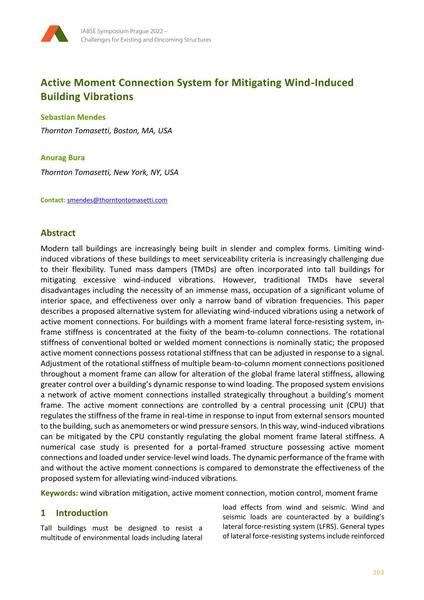Active Moment Connection System for Mitigating Wind-Induced Building Vibrations

|
|
|||||||||||
Bibliographic Details
| Author(s): |
Sebastian Mendes
(Thornton Tomasetti, Boston, MA, USA)
Anurag Bura (Thornton Tomasetti, New York, NY, USA) |
||||
|---|---|---|---|---|---|
| Medium: | conference paper | ||||
| Language(s): | English | ||||
| Conference: | IABSE Symposium: Challenges for Existing and Oncoming Structures, Prague, Czech Republic, 25-27 May 2022 | ||||
| Published in: | IABSE Symposium Prague 2022 | ||||
|
|||||
| Page(s): | 203-209 | ||||
| Total no. of pages: | 7 | ||||
| DOI: | 10.2749/prague.2022.0203 | ||||
| Abstract: |
Modern tall buildings are increasingly being built in slender and complex forms. Limiting wind- induced vibrations of these buildings to meet serviceability criteria is increasingly challenging due to their flexibility. Tuned mass dampers (TMDs) are often incorporated into tall buildings for mitigating excessive wind-induced vibrations. However, traditional TMDs have several disadvantages including the necessity of an immense mass, occupation of a significant volume of interior space, and effectiveness over only a narrow band of vibration frequencies. This paper describes a proposed alternative system for alleviating wind-induced vibrations using a network of active moment connections. For buildings with a moment frame lateral force-resisting system, in- frame stiffness is concentrated at the fixity of the beam-to-column connections. The rotational stiffness of conventional bolted or welded moment connections is nominally static; the proposed active moment connections possess rotational stiffness that can be adjusted in response to a signal. Adjustment of the rotational stiffness of multiple beam-to-column moment connections positioned throughout a moment frame can allow for alteration of the global frame lateral stiffness, allowing greater control over a building’s dynamic response to wind loading. The proposed system envisions a network of active moment connections installed strategically throughout a building’s moment frame. The active moment connections are controlled by a central processing unit (CPU) that regulates the stiffness of the frame in real-time in response to input from external sensors mounted to the building, such as anemometers or wind pressure sensors. In this way, wind-induced vibrations can be mitigated by the CPU constantly regulating the global moment frame lateral stiffness. A numerical case study is presented for a portal-framed structure possessing active moment connections and loaded under service-level wind loads. The dynamic performance of the frame with and without the active moment connections is compared to demonstrate the effectiveness of the proposed system for alleviating wind-induced vibrations. |
||||
| Keywords: |
moment frame wind vibration mitigation active moment connection motion control
|
||||
| Copyright: | © 2022 International Association for Bridge and Structural Engineering (IABSE) | ||||
| License: | This creative work is copyrighted material and may not be used without explicit approval by the author and/or copyright owner. |
||||
